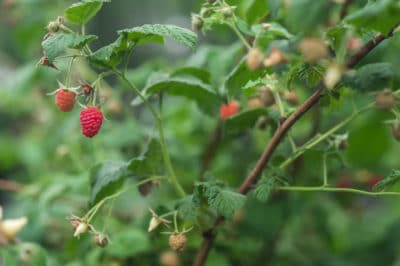Types of Vines
All raspberry varieties produce vines (canes) that live for two years. When two-year-old canes die, there are one-year-old canes already present to keep the plant producing.
Primocanes
First-year canes are called primocanes. During their first year, these canes grow tall and produce leaves on summer-bearing and everbearing types of raspberries. Only everbearing raspberry varieties produce primocanes that bear fruit.
To start a new raspberry bush, one bare-root cane is planted. One cane quickly produces many canes from underground runners or from buds at the base of the floricanes (two-year-old canes). Black and most purple raspberry varieties produce primocanes only from the buds at the base of floricanes. Every year new primocanes will form from this same clump.
The green primocanes of everbearing raspberry plants bear a small number of berries on the upper tips in the fall. The production of berries continues inward and downward on the primocanes of everbearing raspberry varieties until a hard frost. The primocanes turn brown and become dormant for the winter. No fruit will develop on summer-bearing raspberry varieties.
Floricanes
In the second summer of growth, the primocanes that grew the previous year are called floricanes. The floricanes of summer-bearing varieties will produce raspberries from mid-summer to late summer, depending on the USDA Zone. After bearing fruit the floricanes will die. In preparation for next year’s raspberry crop, new primocanes grow among the floricanes. This process continues year after year.
Everbearing raspberry varieties have a different fruiting cycle. The primocanes (now floricanes) that fruited at the tips the previous season will produce a large crop on the bottom of these canes and then die. If everbearing varieties are pruned like summer-bearing varieties, a second crop in the fall is produced on the tips of the new primocanes.
Vine Pruning
After learning the growth cycle of the vines, it is vital to master pruning techniques. Raspberry vines prolifically grow year after year. Old dead vines must be removed to make space for the new ones. Taming the growth by pruning is important for these reasons:
- Pruning allows sufficient sunlight to reach the lower sections of the bushes.
- Pruning improves air circulation to the bushes.
- Pruning helps prevent diseases from developing on the bushes.
- Pruning makes picking raspberries easier.
- Pruning discourages pest infestation.
The ultimate goal of pruning is a large crop of sweet raspberries. Without pruning, a jungle of tangled vines will sprawl over your lawn. Practice excellent pruning techniques and the dream of large raspberry crops should become a reality.
